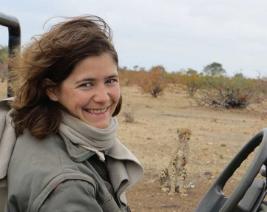
Our cat species are rapidly becoming extinct. The rarer ones exist in fragile habitats which have almost disappeared while others interbreed with domestic moggies (or feral cats) and promote a race of hybrids which can never replace the precious alleles of the rare species. Being generally elusive, cats living in inhospitable regions can be almost impossible to trace. Intensive camera trapping has now proved to be able to estimate densities of populations. While tigers and other Pantherines show up well, speedy, very similar or quite small species of the Felines may be found less easily, but the proof will be in the photographs.
The big problems are low density in the populations and unpredictable movements. Acinonyx jubatus, the cheetah was targeted at specified sites using cameras placed in the traditional grid pattern in Botswana. The Northern Tuli Game Reserve, just north of the Limpopo, was chosen but provided only 9 sitings using this system. However, the use of cheetah scent-marking posts gave 53 images of 7 different adults over a three month period. The length of time for the survey also influenced results with a 130-day survey quadrupling the sitings from a 90-day survey. Sadly that improvement seemed less useful when the same individuals were spotted and the population density therefore remained the same.
The National Geographic Society, Rufford Small Grant, Zoofaris Foundation and Mashatu Game Reserve funded the experiment, with the field work carried out by Eléanor Brassine and collaboration from Daniel Parker of Rhodes University, RSA. Carnivores are rarely found in their natural range as habitat has shrunk in Africa and elsewhere. The lack of dense vegetation in places may help camera placement as animals move along trails in some cases. On the other hand, open situations with a non-trail using species could prove a greater challenge.
Cheetahs in this reserve have been sometimes suspected to be locally extinct. At first this was apparently the case. The 60 locations chosen for the grid survey used one camera per station at random sites. The 2nd survey used field guides' knowledge of 104 scent marking posts. Those within 250m of each other were less useful, so 60 locations were once again chosen.
After 1616 active days of logging, 3346 pics were taken, but the grid layout yielded only 9 of cheetah. The 2nd survey saw 2660 active days, with 3323 photographs. A total of 53 cheetah images (2 females and 5 males) were the happier result. Such a large and fast predator would seem to be easier to trace than smaller cats living in less open habitats, but latrine sites or scent marks have been used for trailing many species before. A precise population estimate is needed when conservation status is investigated, so this non-standard technique could prove to be invaluable. A large home range, very low population densities, the lack of trail use, and especially secretive habits combat the investigation, but this research indicates that such problems can be overcome.
Open access publication is by PLOS ONE as Trapping Elusive Cats: Using Intensive Camera Trapping to Estimate the Density of a Rare African Felid. We have a candidate for investigation in South America. The Andean cat was found to live in much lower locations on the Patagonian steppe, just 5 years ago. More research on many of these smaller cats is vital, given a population of only a few thousand or even lower numbers in some cases.
By Dave Armstrong
Image Credit: Kaizer Sekanonyana
Source: http://www.earthtimes.org/conservation/rare-cats-counted/2895/#kZempYDLpicXiUcH.01
